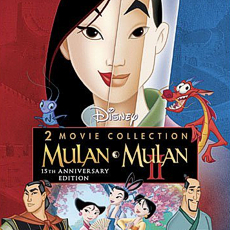Walt Disney Feature Animation (June 19 1998), Walt Disney Home Entertainment (October 26 2004), 2 discs, 88 mins plus supplements, 1.66:1 anamorphic widescreen, Dolby Digital 5.1 Surround, Rated G, Retail: $29.99
Storyboard:
Based on old Chinese folklore and one of Disney’s biggest recent hits, Mulan follows a young headstrong Chinese girl who rebels against her pre-arranged marrying off and swaps her dresses for a soldier’s uniform to take her ailing father’s place in the battle against the Huns. Along the way, she falls for, and gets into a complicated relationship with, her captain, Shang, and is aided and abetted by her ancestral protector, the diminutive dragon Mushu, and a “lucky” bug, a cricket named Cri-Kee. Proving that behind every great man is a greater woman, Mulan is able to use her smarts to help Shang and his rag-tag band outwit the Huns, though there comes a moment when her secret and true identity could well be exposed…
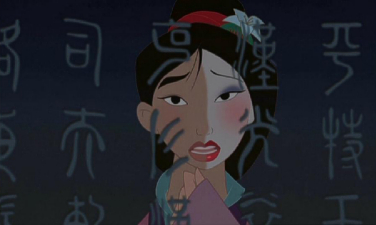
The Sweatbox Review:
Disney’s telling of the ancient Chinese legend of Fa Mulan easily holds up as one of the Studio’s more “classic” animated features amongst the recent offerings. First mentioned as ripe for story treatment as far back as when then Studio head Jeffrey Katzenberg was trying to up the ante on animated films and build on the critical and commercial success of Beauty And The Beast, Mulan was initially plotted as a deep drama, in the vein of Pocahontas and The Hunchback Of Notre Dame.
Once Katzenberg left the Studio, in late 1994, the story was infused with a little lighter touch, and handed over to the then-still fairly green Florida feature unit, who up until that point, had mainly been responsible for Disney’s Roger Rabbit shorts, and small (mostly more “cartoony”) sections of the Burbank animated features. The big question was: could they not only handle such an undertaking, but also one that needed careful treatment and a fine juxtaposition between the overly “toony” feel and true emotional storytelling?
The answer, for anyone who has seen it, is a resounding “yes”, of course, even if some of the animation can sometimes be somewhat unsophisticated in nature. The guys there were still learning the ropes, though do put in sterling work here and certainly built on what was achieved with their follow ups Lilo And Stitch and Brother Bear. Mulan doesn’t quite feel like classic, epic Disney, but it’s not a far off copy, and very much a film from the same stable, still leagues ahead of what other Studios were putting out at the time.
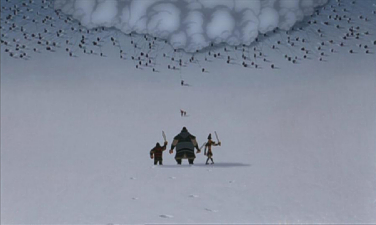
As a piece of storytelling, Mulan is as solid as Disney comes. The script is paced well, with neither the humor nor the drama ever overpowering the other. Directors Tony Bancroft and Barry Cook pack their film with several set pieces, as well as some nicely staged minor moments, which do manage to balance out the film. The use of CGI, still fairly new at the time of production, is done sparingly, though it is sometimes easily possible to pick out those scenes that employ the technique. Most glaringly obvious is the Hun army’s stampede, a sequence inspired by, and that heavily recalls, the not so dissimilar moments in The Lion King with the wildebeests. Still, it’s an exhilarating moment, even if it never quite really reaches the highpoint that it might have done.
Providing his first comic relief role in an animated film (and essentially setting up the tone for his performances in the Shrek films) is Eddie Murphy, who here is bags of fun, and not nearly half as annoying as Donkey could become at times. His Mushu almost walks off with the movie, taking the dual roles of a semi-narrator and guide to Mulan. He keeps tabs on the story, becoming involved when he needs to be and coming up with just the right laugh line to say at critical emotional points – truly a classic Disney sidekick character that really works. For older fans, his line to the guards as he “drops in” during the final fireworks sequence is a very funny throwback to one of his earliest roles!
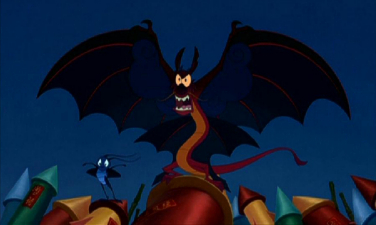
As a fellow comedy relief, Cri-Kee is given much less to do, and almost comes off as an afterthought (indeed, he seemingly disappears for sequences at a time, only to appear again when really needed). Not sure what role he was intended to play, but sometimes he only works when he’s playing off from Mushu himself – a sidekick’s sidekick? Animation wise, things are mostly fine, and Mulan’s transformations from girl to boy are always handled well, and the switch is never at all the hot potato that it could have been. Interestingly, the use of montage in animated films has always been so-so in the end results, but Mulan’s gender-bending and the later recruitments’ training scenes are expertly realised.
Helping things along is the score, by the recently passed away Jerry Goldsmith, and Matthew Wilder’s songs. Goldsmith imbues the film with a couple of highly majestic themes, as was his stock in trade toward the end of his career, but unlike the majority of his Star Trek work, the music here always feels fresh and suits the mood perfectly. Though not technically a musical (actually like many of Disney’s films), Mulan does contain four songs, which strive to push emotion or story forward, to varying degrees of success. Providing Christina Aguilera with an early hit was the pop single version of Mulan’s “I want” song, Reflection, which is right up there with Part Of Your World when it comes to the lonesome musical pinings of Disney’s animated heroines.

An interesting note was that Stephen (Pocahontas, Prince Of Egypt) Schwartz was at one point to be Wilder’s lyricist, only to be replaced by Hercules’ David Zippel at the last moment. There’s no doubting that Schwartz’ take would have been more sombre (perhaps in keeping with the original treatment of the story), though Zippel does display his knack for some fun wordplay, especially in A Girl Worth Fighting For. Of the other songs, Honor To Us All and I’ll Make A Man Out Of You aren’t classics in the Disney canon, but do feel part of the whole overall, helping their respective scenes lift to the emotional wallop they need at their times.
I won’t continue to gush about Mulan’s merits as a great Disney animated film – it’s recent enough for most to have seen it and for you to have formulated your own opinions. The main question is whether this DVD retread, following Mulan’s release as a Limited Issue/Gold Collection title, is worth the double dip? Well, to put it simply…yes, and a worthily packed couple of discs it is too! In short, a pretty great movie and a fine return to the well-stocked packages of old, Mulan has hit DVD in a way that finally does justice to one of the Studio’s most well received recent films!

Is This Thing Loaded?
In a way, when I first read Mulan’s extensive list of bonus features, my mind went back to the exceptional LaserDisc box sets of the 1990s, when all matter of things specifically compiled for the collector were included in such luxury packages. I’m convinced that this 2-disc set basically contains material that was assembled for a LaserDisc box that never happened (apart from being one of Disney’s first DVD releases, Mulan was also one of the last of the Studio’s films to see a bare-bones LD issue).
Dropping the sometimes obligatory full-screen version, which are always redundant and seemingly only included to bolster single disc sets into 2-disc editions, Mulan’s extra goodies start the moment the disc kicks in, with the usual sneak peeks for upcoming product Mulan II (which still only looks “kind of” okay), Bambi (whose digital restoration looks simply gorgeous), and Mary Poppins’ 40th Anniversary, with Pooh’s Heffalump Movie shown as coming to theaters. Also, buried back in the Sneak Peek menu, are additional previews, including a promo piece for Mulan II that’s different that what we’ve seen so far (and includes more good and bad stuff), running three-and-a-half minutes.

Moving onto the main menu proper, and the first extra to grab my attention was the collection of Deleted Scenes, and here we get a glimpse at the in-depth look at production that’s in store in the set, with the most extensive bunch of cut stuff I’ve yet come across for a Disney film. Lasting a total of almost 23 minutes, including introductions from the crew, these early concepts feature several alternative openings to the film, plus an entire demo song, Keep ’Em Guessing, which would have introduced Mushu in a very different way and given him his own theme tune! Unfortunately, the song is rather uninspired, falling into the danger of being a Friend Like Me knock off, with its big band jazz being very out of place in the final film. More fun is an original shadow puppet opening that sets up not only the story but also the China of the time, featuring some gorgeous test animation. Other sequences that ended up on the cutting room floor include some interesting variations on the main villain character, and yet another opening that begins with a hugely majestic choral arrangement that could have been too literal and overbearing for its own good.
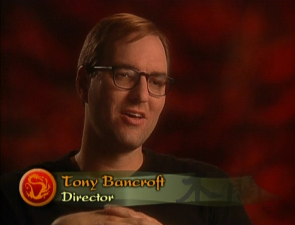
Next up, heading into Backstage Disney, and always a good feature on Disney discs, but seldom promoted (the only mention you’ll see is in the liner notes), is a full-length producer and directors Audio Commentary. Producer Pam Coats is placed in the middle of the soundstage, with her two male helmers placed left and right, which opens up the audio spacing of what can sometimes be crowded affairs and sounds much more pleasing. Not that their comments are in danger of becoming crowded! The trio speak rather dryly and sparingly, not really revealing too many secrets, but opening up just enough to keep it interesting (it’s certainly clear, on hearing about the genesis for Little Brother, that Chris Sanders is definitely a “dog person”). It’s more a discussion about each scene as it unfolds, being more “who worked on what” than an overall dissection of the production. However, the basics of Disney storytelling are touched on, as well as the inclusion of songs and music, with the occasional laugh or in-joke pointed out.

Staying backstage, and Mulan’s Fun Facts is a Mushu-sized look at the production. Those hoping for pop-up trivia throughout the film may be disappointed – this is a brief video clip (from badly dubbed VHS by the looks of things) which features only a few snippets of info, but it’s quickly cut and a fun addition that sneaks in some irreverent stuff as well (such as “if the 27.780 pencils used to draw Mulan were laid end to end…the movie would have never been completed”)! DisneyPedia: Mulan’s World has a Mushu vocal stand-in talking about the various themes and cultural references that the movie contains. Using footage from the film, topics covered range from Mulan herself and her place in Chinese history, to the mythology of dragons and the Great Wall.
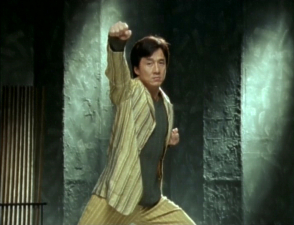
Rounding out Disc One is Music And More, a collection of music videos for songs from the film. About the only thing, apart from a theatrical teaser, included on the original Gold release were the videos for the film’s two main singles, and it’s nice to see those carried over here, as well as two additional clips, one old and one new. Joining Christina Aguilera’s Reflection and 98 Degrees/Steve Wonder’s True To Your Heart (both from the Gold release) are a Mandarin Chinese version of I’ll Make A Man Out Of You, sung by Jackie Chan for release in that country, plus a new version of True To Your Heart, now over-emoted by Disney Channel star Raven. The two previously released clips look marginally better than they did on the original release, while Jackie Chan’s video is basically a sung to camera shoot with his version of the track the original film arrangement (Chan supplied the dubbed voice in China). The Raven clip looks newer, but is little more than just her in the recording studio and a promotion for the DisneyMania 2 compilation (as the always-onscreen wording keeps reminding). Still, at least these are all full-length videos and not the 30-second spots we used to get on Disney’s DVDs.
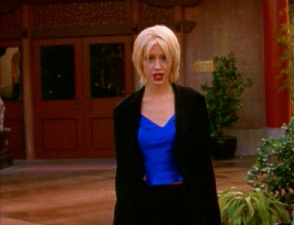
Whereas that may be the end of it for most Disney discs out there, we’ve a whole other disc of supplemental material to get through, so it’s on to Disc Two we go, and a thoroughly in-depth look at the production’s progression. At this point, everything takes on a full-frame 4×3 look, with two main headings: Music And More, and Backstage Disney. Heading into the music section, we find a leftover from what I suppose could have been included on disc one, another music video for another version of Mulan’s theme, Reflection (3:34 minutes). This is a Spanish-language edition, which truly shows up how “cut and paste” some of these clips can be: it’s a virtually shot-for-shot identical version of the Christina Aguilera video, and I wouldn’t be surprised if they’d shot both at the same time, setting up the shot and having the two singers perform their parts before moving on to the next set up.
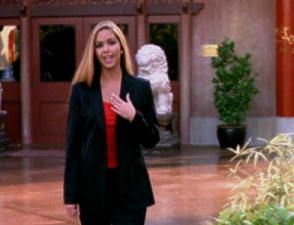
Unfortunately for the unlucky singer here, Disney have chosen not to identify her, merely labelling the clip “Spanish Version”, which seems to be an injustice. She may not have Aguilera’s pipes, but no doubt she’s a gifted singer and looks every inch the part, and a quick check on the IMDB shows her up in the soundtrack section as a Mexican actress Lucero, who also provided Jane’s voice in the Spanish dub of 1999’s Tarzan. Shot on what looks like 16mm, the video doesn’t look quite as clean as the previously seen Aguilera version, probably due to some PAL-to-NTSC trickery, but it’s something that not many will notice.
Delving into the production history is more from the Backstage Disney vaults: a collection of six headed subjects that cover everything from the original poem that inspired the legend of Mulan to international releases. While there isn’t a Play All option that seamlessly runs all these pieces as one cohesive documentary, it seems this is mainly because everything has been sliced up into these subsections. Within a given topic however, clips can be viewed in one sitting.
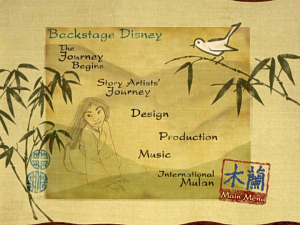
So, it’s off to The Journey Begins first, which contains Discovering Mulan, an introduction of the Disney artists to the tale and their research, The Ballad Of Hua Mulan, the original poem that inspired the legend, plus two Early Presentation Reels (from 1995 and 1996 respectively), which used to be a mainstay on those LD sets of old and a welcome inclusion here. Adding up to around 17 minutes of material, the pieces here do not seem rushed or full of fluff, though they are edited in typically slick fashion. Topics covered range from producer Pam Coats talking about the artists’ research trip to China, complete with plentiful amounts of VHS footage, photo stills and early concept sketches. The poem is told through narration, further concept images and expertly edited music from the great Goldsmith score – an artfully composed piece that almost works as a short film in its own right.
The two presentation reels could have benefited from an intro or two to place them in context, and would have helped those not familiar with the production’s history. The first seems to be not much more than the “transformation” scene told in storyboard form, while the second is longer, and more what one might be used to with such things: a “tone guide” with temp music, which outlines the film’s concepts in visual form. This looks like it could have been from back when the production was going for all out dramatic emphasis, with heavily saturated colors and strongly stylised ideas – an interesting look at the developmental process.
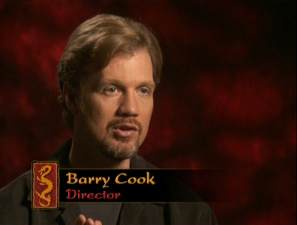
In The Artists’ Journey, we find several more clips looking at the animated filmmaking process. Firstly, Finding Mulan is a lengthy seven-minute piece on how the artists approached the character, both in personality and visual style. The participants talk about how the story changed from being more of the usual Disney “protagonist wants to escape their humdrum life” take to becoming the “girl with a mission” story that Mulan would finally appear as. A Storyboard To Film Comparison is next, presented in the good old fashioned way that us LaserDisc enthusiasts remember: a recurring sequence of the same scene played through various stages of production (don’t worry, a multi-angle proposition that allows toggling between the clips is also an option, which DVD users may be more comfortable with). Lasting around a minute-twenty, the clip shows an early Mushu scene as storyboarded by Chris Sanders, from initial concept art to final color and rendering. A third choice has both angles played out on one screen, which is probably the best way to compare the scene instantly.
In Design, three featurettes outline the tone and style directions the film variously went off in, as well as obviously where things ended up. Individually selectable or available with a Play All option, the first of these, Art Design, speaks in depth on much of the concept art we have already seen, and places these pieces of art into context. Character Design builds on the artists’ philosophy on the artwork in the film, and how the characters were designed to be placed within their respective backgrounds without any clashing of styles. Ballad Of Color looks at the way the artists used color to help pack the emotional punch of certain scenes, as well as how they adapted cultural Chinese colors for costume choices and scene moods. After the 14 minutes of material has played, the viewer has the choice to browse through three Still Galleries, which allow for in-depth appraisal of Character Design, Visual Development and Backgrounds And Layouts, all broken down into subsections for each character, and topics such as Landscapes and Architecture – an extensive collection of fascinating developmental images.
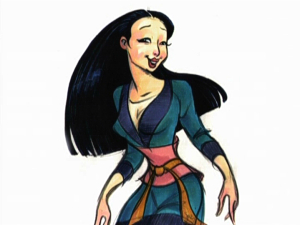
Moving on to Production, and two headings offer a couple of options each. Progression Demonstrations shows two scenes, Mushu Awakens and Matchmaker Meets Mulan, both shown in various stages of development. A little like the Storyboard Comparisons, these scenes build on that by going through the various stages in-between, from sketches and rough animation, to clean-up, effects and final color. As before, these are presented in sequence, or via the angle mode that allows for switching between the stages. Digital Production is made up of two featurettes, The Hun Charge and Digital Dim Sum, that take in the use of CGI in the film, from the evil Hun army’s set-piece attack to the quick way the technicians found to replicate large numbers of crowds for Mulan’s final sequences, and a new adaptation of the Multiplane Camera (pre Deep Canvas). All in all, this very interesting Production section adds around a further 17 minutes to the bonus section.
The Music section jumps right into another clip, Songs Of Mulan, which outlines how the songs were spotted in the film and the emotional tone each should have. While Mulan isn’t a full-on musical per se, these moments are an integral part of the overall package, and the just-over-five minutes awarded to the subject here don’t really do the process justice. Also, especially given his recent death, it’s an glaringly missed opportunity not to touch on Jerry Goldsmith’s score for the film – he isn’t even mentioned here, despite being a grand old master of film music and having this particular score Oscar nominated in 1998. Very much an outstanding omission, and this set’s major dent in receiving top marks.
Finally, International Mulan features a final two featurettes, plus a Publicity Art gallery. Mulan’s International Journey looks at the usually underrated folks at Disney Characters International and the job they do translating each and every animated movie into foreign languages. The care put into these translations is readily apparent, and speaks volumes for the always big box office that Disney pictures do internationally. The task of bringing Mulan back to Chinese audiences is brought up, with the casting of Jackie Chan in Captain Shang’s role seen as more than an important part of the film’s success there. We also see brief moments from the Mandarin version of the Reflection video, surely a more interesting addition than the Spanish clip included?
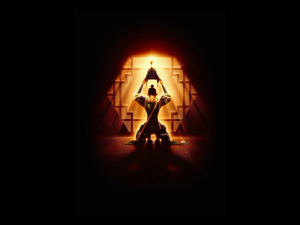
I’ll Make A Man Out Of You is reprised (in full-frame video) in a multi-language version, something that I always find a fun feature when Disney includes them. Cycling through the various languages that the film was released in, it’s further credit to the Disney Character people that it still works and that the voices match up as well as they do, both to original intention and in lip-sync. Both the international-focused featurettes add up to nine more minutes of material. Though the original Limited Issue/Gold Collection release featured a pre-release teaser trailer, we have to make do with just the Publicity Art gallery rounding things out here, but at least it does feature some striking images that show how the film was sold both in America, around the world, and in re-issue.
All in all, the non-appearance of a redundant full-screen version has meant the filling of the discs with more original content. While a couple of trailers wouldn’t have gone amiss, the extensive deleted scenes, music videos and early concept works surely make this up, and it is fun to explore a production again in such detail (as opposed to simply sitting through a collection of EPK fluff pieces). A solid return to the informatively packed disc sets we used to associate with Disney, this Mulan disc complements the film nicely, places it in context, and reveals some fascinating stuff on its making along the way. And who could ask for more than that?
Case Study:
Coming out just a couple of weeks after the packed Aladdin set, Mulan was originally intended to appear in a similar boxed gift set. Dropped for understandable reasons, what we have ended up with is a standard 2-disc package from Buena Vista, with the disc in a slim-line keep case housed within an outer slipcase. The slip is nothing special, merely re-printing the cover art found inside (albeit with a little more image information on the sides), and it doesn’t fold out as the Aladdin case did. Inside, things are different, with a fine DVD Guide offering a “map” to the contents on each disc, as well as the usual promo booklet that pushes Mulan II and some money-saving coupons.
Ink And Paint:
I have to admit to being a big fan of Mulan’s original Limited/Gold Collection transfer from an actual film print, and was on the lookout for anything less than exemplary here. Presented for the first time direct from a digital source and in anamorphic widescreen, Mulan should look fantastic, in theory. However, and perhaps since I was looking too hard, I did notice several artefacts, and being an old-fashion purist, I kind of still warm to the older release’s actual print, anamorphic or not! Not that there’s anything wrong here, but as stated in several recent Disney reviews, I do find the lack of grain and the very clean look of these digital transfers to look and feel a little too clinical.
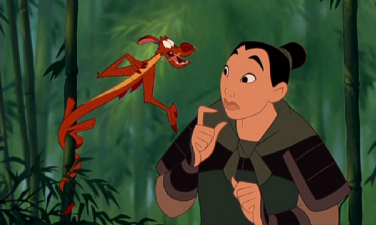
Presented in 1.66:1, this edition opens up the mattes, providing a little more picture information than on the older 1.85 disc and looking less cramped for it. Not one of Disney’s “deepest” looking films (characters are block colored as opposed to having the subtle light and shadows of a Lion King or Tarzan), Mulan holds up well here, and the image should please the majority.
Scratch Tracks:
In a nice surprise, we can get to hear Mulan in Mandarin Chinese – something which is highly entertaining to see and lends somewhat of an edge of “authenticity”. Sticking with the English track we know and love, and it is here presented in Dolby Digital 5.1, sounding very much like the original track on the first Limited/Gold releases. Certainly, jumping between the two didn’t bring up any noticeable changes, so it’s basically a reprise of that standard, but more than serviceable track, with overall strong bass and a decent high-end. Options for French and Spanish dubs are also included, as well as English subtitles.
Final Cut:
Some varying degrees of over familiarity just slightly hold back Mulan from being a truly great Disney film, but it’s certainly one of the Studio’s better efforts of the late 1990s. This long-rumored Special Edition DVD does the film justice in more ways than one, providing just about the right amount of in-depth material on its production. In many ways, the supplemental features included here almost make Mulan stand out as a more important film than it possibly is, but as the first of the three features to come from the Florida unit, it is perhaps deserved of that honor. The bonus of not including a full-screen version squarely aims this set at collectors and true fans of the film, and most will be pleased with the abundance of extra material on offer here. Trailers, as always, would have been icing on the cake, but it’s a very decent package in itself, and for those aforementioned fans, well worth picking up even if you have one of the original releases.
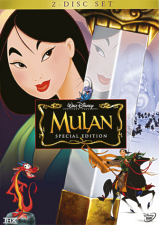 | ||
 |









